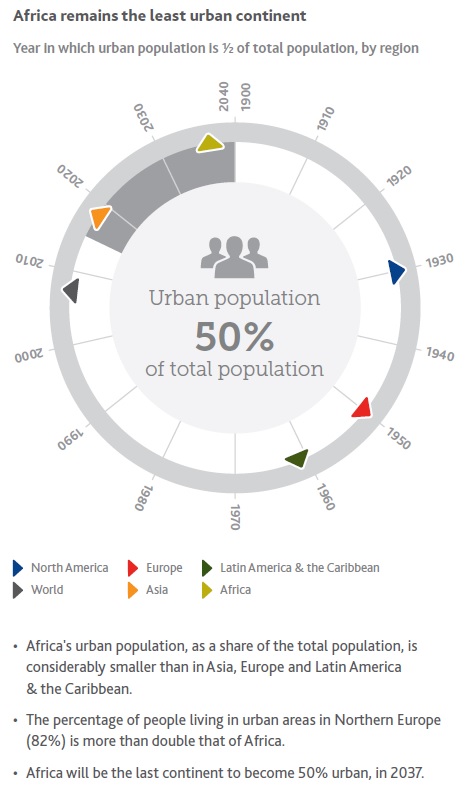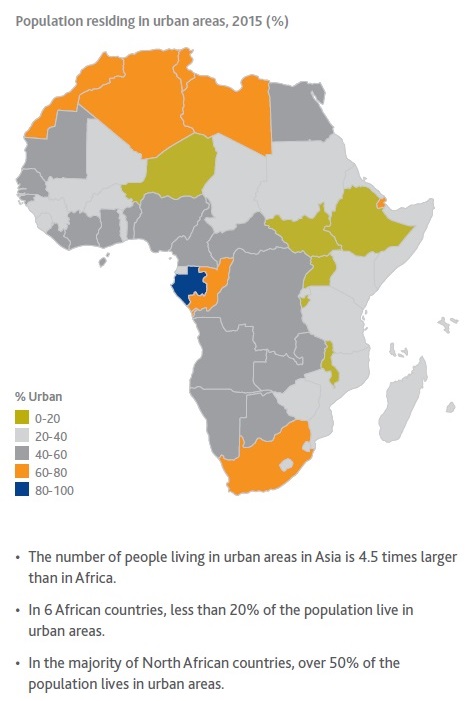News
2015 Ibrahim Forum Facts and Figures: African Urban Dynamics

Held annually since 2010, the Ibrahim Forum aims to tackle specific issues that are of critical importance to Africa, and require both committed leadership and governance.
Bringing together a diverse range of high-level African stakeholders belonging to various public and private constituencies, as well as selected non-African partners, the Forum is an open and frank discussion. It aims to go beyond stating issues and renewing commitments by defining pragmatic strategies, operational action points and shared responsibilities.
In order to facilitate this and to focus energies on a constructive debate, the Foundation publishes a ‘Facts & Figures’ report for each Forum. The report compiles the best and most recent data and analysis relevant to the issues to be addressed.
The focus of the 2015 Ibrahim Forum is ‘African Urban Dynamics’. Cities have the potential to play a pivotal role in Africa’s development. As the last continent in which 50% of the population will become urban, Africa is expected to accommodate almost 900 million additional urban dwellers within the next 35 years. This is more than 3 times the current population of Indonesia, or slightly less than 3 times the population of the USA. This urban growth is characterised by a massive youth surge. Meanwhile, economic growth is often taking place without job creation, inequalities are widening and per capita incomes are up to 5 times lower than in other regions at similar urbanisation levels. Moreover, the new century brings unprecedented pressures linked to climate change, global pandemics, worsening security threats and growing migration flows.
This is a huge and immediate challenge. However, properly managed, with sound governance and focused leadership, it could also be a transformative opportunity. Urban policies and planning are about people’s daily lives. They have the potential to foster and trigger sustainable and equitable development. They may also contribute to a renewed sense of participation, public service and citizenship.
The ‘African Urban Dynamics’ report provides data-driven content for the discussions at the 2015 Ibrahim Forum in Accra on 21 November, and beyond. With the urban agenda being so crucial for Africa, many global institutions will continue the debate in the coming months and will hopefully ensure that decisions are implemented. This report and event are contributions to this process.
The report presents an overview of the sheer demographic challenge; how this translates into the required delivery of goods and services; the impact on people’s lives; and the significance of governance and leadership in the solution.
The research for ‘African Urban Dynamics’ has reinforced a primary challenge in the drive to harness the power of urbanisation on the continent: data availability. This vacuum will only be highlighted by the need to provide guidance for the implementation of urban development projects, and measure the progress of the Sustainable Development Goals (SDGs), specifically Goal 11, but also almost every other goal of the agenda. Without a concerted effort to address the data challenge, the urban opportunity will prove that much more difficult to harness.
Highlights
-
In the next 35 years, Africa will need to accommodate almost 900 million new urban dwellers, which is equivalent to what Europe, USA & Japan combined have managed over the last 265 years.
-
Rwanda has the 2nd fastest urban growth rate in the world, after Oman.
-
Cairo, Africa’s most populous city, manages a population that is larger than each of the 36 least populous countries on the continent.
-
¾ of Africa’s urban population is younger than 35.
-
Almost ½ of Africa’s urban population lives in slums & informal settlements.
-
Inequality in African cities is the 2nd highest in the world.
-
Youth unemployment in Africa is 3 times higher in urban areas than in rural areas.
-
In Kinshasa, there is only 63m of paved road per 1,000 inhabitants, as opposed to 1,000m per 1,000 inhabitants in developing countries.
-
61% of urban employment opportunities in Africa are informal.
-
In Dakar, 1 million working hours are lost every day due to traffic congestion.
-
In Lagos, there are 200,000 commercial motorcycles.
-
Opened in September 2015, the Addis Ababa light rail carries 60,000 passengers per day.
-
Around 1⁄3 of urban dwellers in sub-Saharan Africa have no access to electricity.
-
37 out of the 54 African countries are still more than 50% rural.
-
In 2050, Africa is expected to host nearly ¼ of the global urban population.
-
Between 1988 & 2012, Bangui has been flooded 7 times & Lagos 4 times.
-
By 2050, it is estimated that Abidjan could lose $1 billion due to sea-level rise.
-
Residential electricity consumption per capita in Africa is only ½ that of China.
-
Mauritius, Swaziland & Zimbabwe are the only 3 African countries to have de-urbanised between 2010 & 2015.
-
In Nigeria, more than 80% of households use kerosene, charcoal or wood for cooking.
-
Waste generated in most urban areas in Africa could quadruple by 2025.
-
Agbogbloshie, near Accra, has become the world’s largest e-waste dumping site.
-
In Africa, less than 50% of solid waste is collected & only 5% is contained or recycled.
-
Nigeria’s housing shortage is estimated at 17 million units.
-
The total resources of local authorities in Africa were estimated in 2010 at $52 per capita per year.






